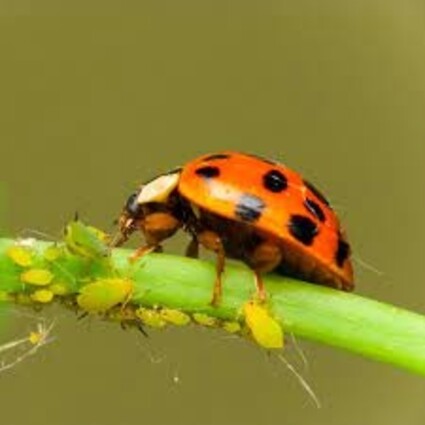Beneficial Insects: Twice as Many "Good Guys"
Last updated 5/16/2023 at 6:45pm

A lady beetle larvae can eat as many 'bad bugs' as the more recognizable adults, up to five thousand in a lifetime
Gardeners, another week has quickly passed, and we are well into gardening season! Last week we discussed 'pests' which prey upon gardeners beloved tomatoes! So, it is only fitting that this week we expand the discussion a bit. Most gardeners will agree that insect's rule! Okay, some of you rolled your eyes...then perhaps not (readers-your silence is deafening)! Seriously, did you know there are approximately 250,000 insect species in the U.S. and about one eighth of them (around 30,000) live in Texas! There are more insect species than all other plant and animal species combined, and each of us is continuously surrounded by insects, no matter where we are (inside or out)!
Unfortunately, we tend to characterize all insects placing them into the 'bad guys' category, since the more familiar ones tend to bother us the most (you know the ones I am speaking about SETX)! There are multitudes of insects which damage crops, and many are known vectors (transmitters) of disease. About 3% of the insect species are 'economic' pests which damage crops yet more than twice as many, 7% (about 17,500) are classified as beneficial insects! Beneficial insects are either predators or parasites of nuisance insects, some of which pollinate flowers, vegetables, and fruit. The remaining 90% of insect species provide food for animals and assist in organic matter decomposition.
To become effective gardeners, we need to learn as much as we can about the life stages of beneficial insects. For example, the larvae of a lady beetle or a lacewing look nothing like adults. Lady beetle larvae appear as "psychedelic" colored (purple & orange) little alligators with six legs. Gardeners are often surprised to learn these insect larvae are not nuisance pests! A lady beetle larvae can eat as many 'bad bugs' as the more recognizable adults, up to five thousand in a lifetime.
Gardeners, by now each of us must realize there will be pests feeding on our plants this and every season: aphids, caterpillars, spider mites, white flies, thrips, to name but a few. Initially, we need to consider if the pest population is large enough to do damage, and then determine if the population warrants treatment with a pesticide (this should be the last resort and one this gardener seldom ever uses). Look around and thoroughly inspect plants to see if beneficial insects are present, and if so, allow them time to perform their duties! Understandably, aphid populations rapidly increasing due to tasty, tender young plant growth, but note that within a few days beneficial insects, such as syrphid fly larvae, lady beetles, and lacewings can quickly "harvest" aphids, drastically reducing the population without a gardeners intervention (meaning no insecticide needed).
There are numerous aphid enemies but one of the most amazing is called a parasitoid. It's a tiny wasp that lays an egg inside an aphid. The wasp egg hatches, and the larvae eats the aphid from the inside out, killing the aphid in the process, leaving a lifeless, puffy, brown (exoskeleton) shell known as a mummy. During the wasp's final transformation into its adult stage, it cuts a hole in the top of the aphids' exoskeleton, emerging to continue the process. Inspect plants and search for aphid "mummies." Once found, realize nature is working her due diligence noting there is no need to assist her with pesticides, as they destroy pests as well as beneficial insects. Let me emphasize that aphid populations rebound more rapidly than beneficial insects and you might ask why? Unfortunately for plants, aphids are born pregnant, reproducing at an exponential pace, that far out-paces beneficial insects!
Gardeners, should note there are many plants which attract beneficial insects that can be planted to help maintain increased populations of the "good guys." Tropical or Mexican Milkweed (Asclepias curassavica) is a great plant to build up a population of insects that feed on aphids. This is because yellow aphids are attracted to tropical milkweed (magnetic attraction for them) but that do not feed on most other landscape plants. Aphid predators also will feed on aphids in other areas of the garden, and pollinators such as monarch butterflies, relish the nectar-rich flowers. Beneficial insects are also attracted to yarrow, anise, dill, fennel (plants with flat flower heads) or daisy flowers (chamomile & oxeye), as well as many salvias and flowering herbs.
It must be noted that gardening success is directly proportional to time spent in the garden! A gardener's ability to quickly spot "symptoms" early is paramount in determining causal factors, assigning severity, increasing, or corrected without chemical intervention! Learn to identify beneficial insects through their life's stages. Identifying parasitized aphids and caterpillars can provide gardeners with enough details that natural controls are working. If you determine pests are beginning to win the battle, and more drastic action is necessary, use the least toxic, pest-specific (targeted) control.
The time has come for each of us to forget the expression, "The only good bug is a dead bug!" Our gardens are filled with "good guys" that are gardeners' friends, who are counting on us to help them! Learn to recognize them, take steps to preserve and encourage them to make our gardens their home.
So long for now fellow gardeners, let's go out and grow ourselves a greener, more sustainable world, one plant at a time! If you have gardening questions, email me: [email protected] or phone the Orange County Master Gardeners Helpline: (409) 882-7010.






Reader Comments(0)